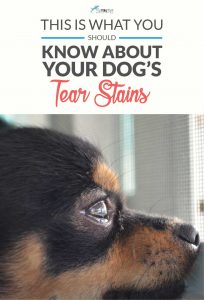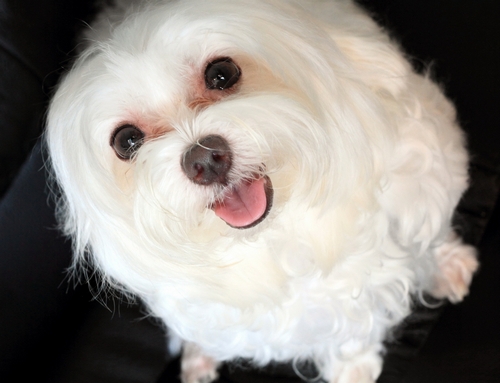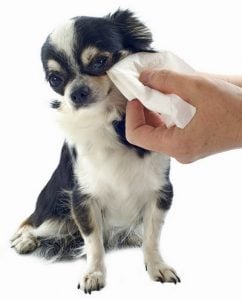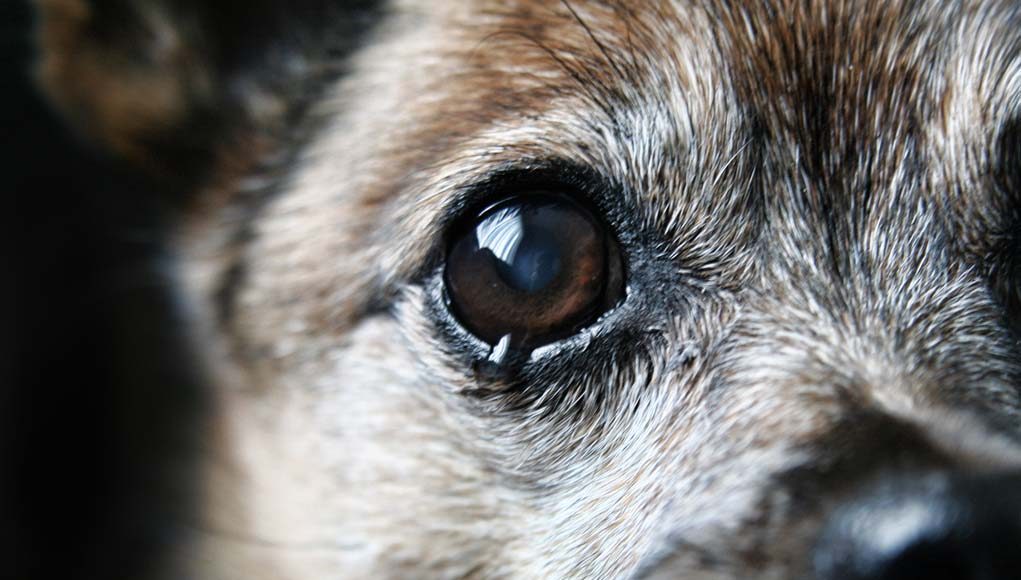Tear stains are an eye-sore (no pun intended). There's no doubt that they aren't pleasant to look at, but did you know there are also some health concerns that you should be mindful of when it comes to tear stains on dogs? So what are they, why do some dogs get them more than others and how do you get rid of tear stains on dogs?
A common misconception is that tear stains only happen around a dog's eyes. Actually, the same ugly reddish-brown stains can occur around the muzzle, in between the toes and underneath the eyes. Typically it's the discoloration under the eyes and on the muzzle that upset pet owners, as this takes away from their pup's adorable appearance.
 It's usually breeds with white colored coats that are the most affected by tears stains on dogs, but any dog can have them. Obviously, they are more noticeable on dogs with light colored fur. Breeds that are most susceptible to tear stains include:
It's usually breeds with white colored coats that are the most affected by tears stains on dogs, but any dog can have them. Obviously, they are more noticeable on dogs with light colored fur. Breeds that are most susceptible to tear stains include:
- Maltese
- Lhasa Apso
- Shih Tzu
- Poodles
- Pekingese
- Pug
- Cocker Spaniel
The causes of tear stains can be greatly varied. It may be something that you can easily change or it may be an issue that you're just going to have to deal with. There are a lot of products available now to help fight tear stains on dogs, but the first thing you'll need tod do is have a talk with your veterinarian.
RELATED: 25 Most Serious Dog Health Symptoms That Cannot Be Ignored
The Truth About Tear Stains on Dogs
Talk to your vet
Dogs aren't born with tear stains, which means that one day you're going to notice them beginning to form. Even if you haven't noticed any other issues with your dog's eyes, he needs to be seen by a veterinarian as soon as possible.
Do not try to treat tear stains on dogs with any type of over-the-counter or home remedy before speaking with your vet.
Tears stains may be a small issue that can be easily resolved by something simple like changing your dog's diet. However, there could be an underlying medical condition that needs to be treated properly. Trying to treat it yourself could cause the problem to become worse and may even do permanent damage to your dog's eye.
Your vet will examine your dog's eyes to make sure there are no foreign objects in them, and then they'll look for a cause of the discharge. If there is a chronic condition present, they may refer to a veterinary ophthalmologist. They'll also look for diseases or infections that may be causing a problem with your pet's peepers.
FULL GUIDE: How to Clean Dog Tear Stains (step by step)
Possible causes of tear stains on dogs
The most common cause of tear stains on dogs is epiphora. This is the medical term given when your dog's eyes produce too many tears. The tears will overflow and cause tear stains (hence the name). Epiphora is not a condition, it is a symptom that is associated with a number of medical conditions.
Like us, a dog's tear ducts produce tears to lubricate the eye and flush out any debris that may happen to get into them. Normally, there is a small hole that allows excess tears to drain away from the eye and down the dog's throat.
 As long as this drainage system is working properly, you shouldn't notice tear stains on dogs. Sometimes there is an issue that prevents the tears from draining. These problems could include:
As long as this drainage system is working properly, you shouldn't notice tear stains on dogs. Sometimes there is an issue that prevents the tears from draining. These problems could include:
- Eyelids that are turned inward
- Shallow eye sockets
- Excessive hair growth around the eye
- A blockage in the tear drainage hole
As I mentioned, any dog can get tears stains, but they are obviously more noticeable on white breeds. If your dog has long hair on his face he may be more susceptible to developing tear stains as well.
Brachycephalic breeds (breeds with pushed-in snouts) often have tear stains. Our boxer falls into this category. The reason these breeds are likely to get tear stains on dogs is because they often have hair growth in skin folds around the eyes, and they are also known to have shallow eye sockets. That's what gives them the bug-eyed appearance.
RELATED: Dog Grooming Supplies 101 – The Ultimate Buyers' Guide
Possible treatments for tear stains on dogs
Remember that it is extremely important to consult a veterinary professional before doing anything to treat your pet's tear stains. Your vet will work with you to come up with a treatment regiment, and it is likely to include one or more of the following:
- Proper facial grooming – Whether you need to trim your dog's facial hair or clean underneath his eyes where the tear stains build up, you'll definitely need to step up your grooming game.
- Changing his diet – Food allergies and improper nutrition may be an underlying cause of tear stains on dogs.
- Changing food bowls – Plastic food bowls can harbor bacteria that will get on your dog's face when he is eating or drinking. Switching to stainless steel bowls and making sure to wipe them out daily will prevent this.
 If your dog has shallow eyelids, there isn't much that can be done to rectify the issue. However, certain conditions may be fixed with surgery or your vet may prescribe eye drops or medication to help relieve the underlying cause of your dog's tear stains.
If your dog has shallow eyelids, there isn't much that can be done to rectify the issue. However, certain conditions may be fixed with surgery or your vet may prescribe eye drops or medication to help relieve the underlying cause of your dog's tear stains.
If you're interested in an all-natural remedy and you vet isn't open to it you can also speak with a holistic veterinarian in your area.
If you need to clean your dog's eyes regularly and you're not comfortable doing it or your dog isn't agreeable, seeking the help of a professional groomer may be your best option.
They have lots of experience both trimming canine facial hair and cleaning tear stains. A local groomer may be willing to walk you through this task the first couple of times until you're comfortable enough doing it on your own.
WATCH NEXT: How to Give A Dog Eye Drops (Video Guide)















